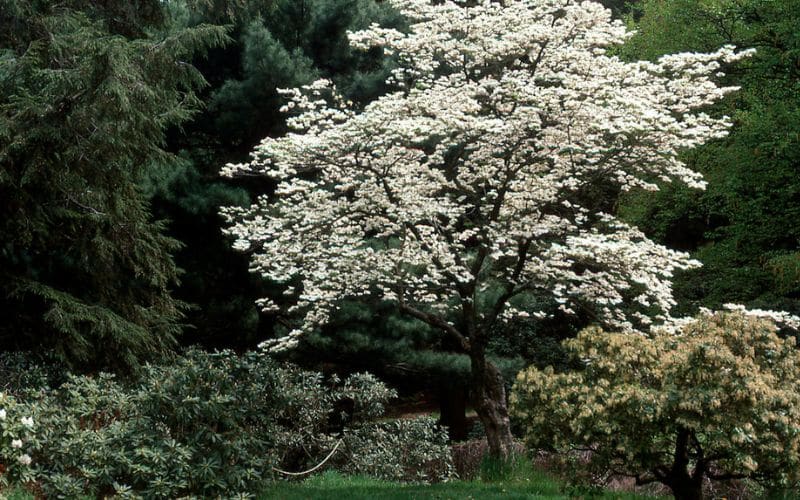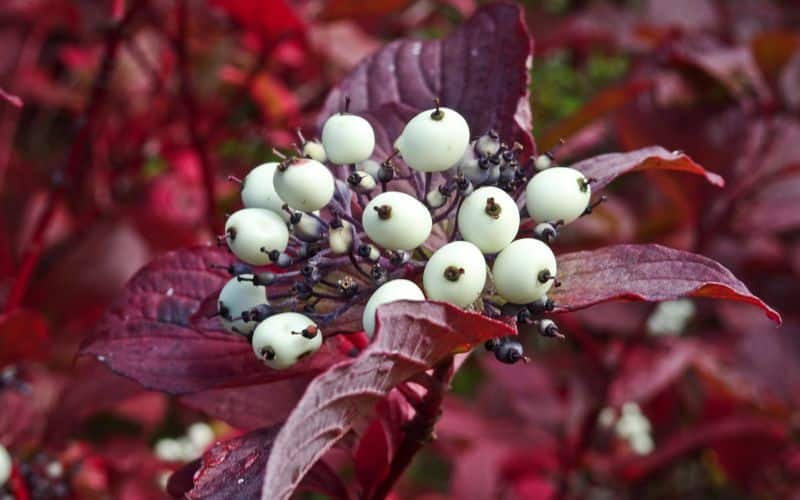
The Dogwood tree, specifically the Eastern Flowering Dogwood, holds a special place in the landscapes of southern Ontario. Known for its stunning white flowers and elegant form, this tree is not only a visual delight but also a symbol of the unique Carolinian zone of southwestern Ontario.
The Eastern Flowering Dogwood in Ontario
The Eastern Flowering Dogwood (Cornus florida) is a remarkable tree native to the Carolinian zone of southwestern Ontario. This understory species, though once fairly common, is now listed as endangered, with less than 2,000 trees estimated to remain in the region. It grows best in the milder regions of Southern Ontario (Zone 5-7), offering a magnificent display of white flowers in late spring.
What It Looks Like
The Flowering Dogwood is easily recognized in spring when four large white flower-like bracts appear before the leaves expand. The leaves are opposite, simple, often with wavy edges, and turn red in the fall. The fruits are bright red, in clusters that may persist after the leaves have fallen. Large specimens have square, alligator skin-like plates, making it a favorite ornamental tree.
Where It Is Found
Flowering Dogwood is native to the Carolinian zone of southwestern Ontario but is becoming increasingly rare due to an anthracnose disease. It is listed as provincially and nationally Endangered and is protected under the Endangered Species Act, 2007.
Key Features
Height and Size: They grow up to 10 meters high and 20 cm in diameter.
Flowering: Gorgeous white flowers bloom in late spring.
Availability: Currently out of stock in some native plant nurseries.
Other Dogwoods in Ontario
In addition to the Eastern Flowering Dogwood, Ontario is home to other native Dogwoods like Red Osier Dogwood (Cornus Serica), which grows easily through much of the province. This plant is prized not only for its flowers but also for its unique red stems.
Conservation Efforts
The rarity of the Eastern Flowering Dogwood has led to significant conservation efforts, particularly in the Carolinian zone of southwestern Ontario. This small area southwest of Toronto stretches down to the shores of Lake Erie and is the only region in Canada where this species can be found.
Legal Protection
As an endangered species, Eastern Flowering Dogwood has been protected from being killed, harmed, harassed, captured, or taken since 2009. In addition, the habitat of Eastern Flowering Dogwood is protected from being damaged or destroyed, with habitat protection in place since 2009.
Recovery Strategy
The Ontario Government has developed a recovery strategy for the Eastern Flowering Dogwood. It recommends areas where natural populations occur to be prescribed as habitat within a habitat regulation. This strategy is in line with the cooperation of the Accord between the Government of Ontario and the Government of Canada.
Nature Conservancy of Canada
Organizations like the Nature Conservancy of Canada are actively involved in the conservation of the Flowering Dogwood. The primary threat to this species is a fungal disease called anthracnose, and the conservancy’s efforts are aimed at preserving and protecting the remaining populations.
Local Initiatives
Local Conservation Authorities and environmental groups are also contributing to recovery efforts. Planting and protecting Eastern Flowering Dogwood in suitable habitats, along with long-term fire suppression, are part of the strategies to increase shading and reduce habitat suitability for dogwoods.
Public Participation
You can help the recovery efforts by protecting the Eastern Flowering Dogwood in your area. Contact your local Conservation Authority or Ontario’s Ministry of Natural Resources Species at Risk biologist if interested in planting as part of the recovery strategy.
The conservation of the Eastern Flowering Dogwood is a collaborative effort involving government agencies, conservation organizations, and the public. These concerted efforts reflect the importance of preserving not just a beautiful tree but a vital part of Ontario’s ecological heritage.

Planting and Care
For those interested in planting Dogwood trees, it’s essential to choose the right location and provide proper care. The Dogwood tree thrives in the milder regions of Southern Ontario and requires specific attention to soil, sunlight, and watering needs.
Soil
Type: Plant in well-drained, moist soil that is not overly wet. Dogwoods prefer slightly acidic loam but can adapt to various soil types.
Amendment: For rich and fertile ground, amend planting holes with a 50 percent mixture of compost to soil.
Sunlight
Shade Tolerance: Flowering dogwoods can be grown in sun or shade. Trees planted in partial shade generally perform better.
Full Sun: Dogwoods can tolerate full sun if they are kept moist, especially the fast-growing varieties.
Watering
Frequency: Due to their shallow roots, Dogwoods may dry out quickly. Water the tree at least twice a week in most areas and more during dry spells.
Moisture Preference: The best time to plant white dogwoods is in the spring when the soil is moist, and before the tree growth begins.
Maintenance
Pruning: As a rule, dogwood trees don’t need much maintenance, but pruning may be occasionally required to shape the plant.
Feeding: They are not heavy feeders, but soil improvement can enhance growth.
Planting Tips
Best Time: Spring is the ideal time for planting, aligning with moist soil conditions.
Location: Choose a planting site that accommodates the tree’s growing conditions, considering sunlight, soil type, and moisture needs.
Additional Considerations
Understory Tree: Dogwoods are typically an understory tree in the wild, reflecting their preference for partial shade.
Native Varieties: Consider native species like Cornus florida, which are adapted to local conditions.
Planting and caring for Dogwood trees in Southern Ontario is a rewarding endeavor that brings beauty and ecological value to the landscape. By understanding the specific needs of this tree and providing the right conditions, gardeners can enjoy the stunning display of flowers and the year-round interest that Dogwoods offer.
Conclusion
The Dogwood tree in Ontario is more than just a beautiful addition to the landscape; it’s a symbol of the region’s unique biodiversity and a reminder of our responsibility to protect endangered species. Whether you’re a gardener, a nature enthusiast, or simply someone who appreciates the beauty of the outdoors, the Dogwood tree offers a glimpse into the rich natural heritage of Ontario.









